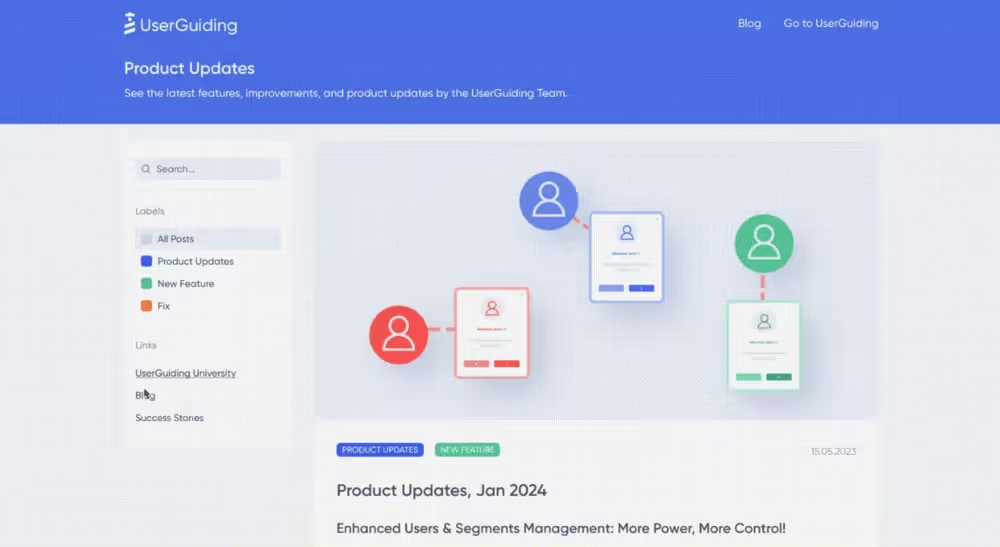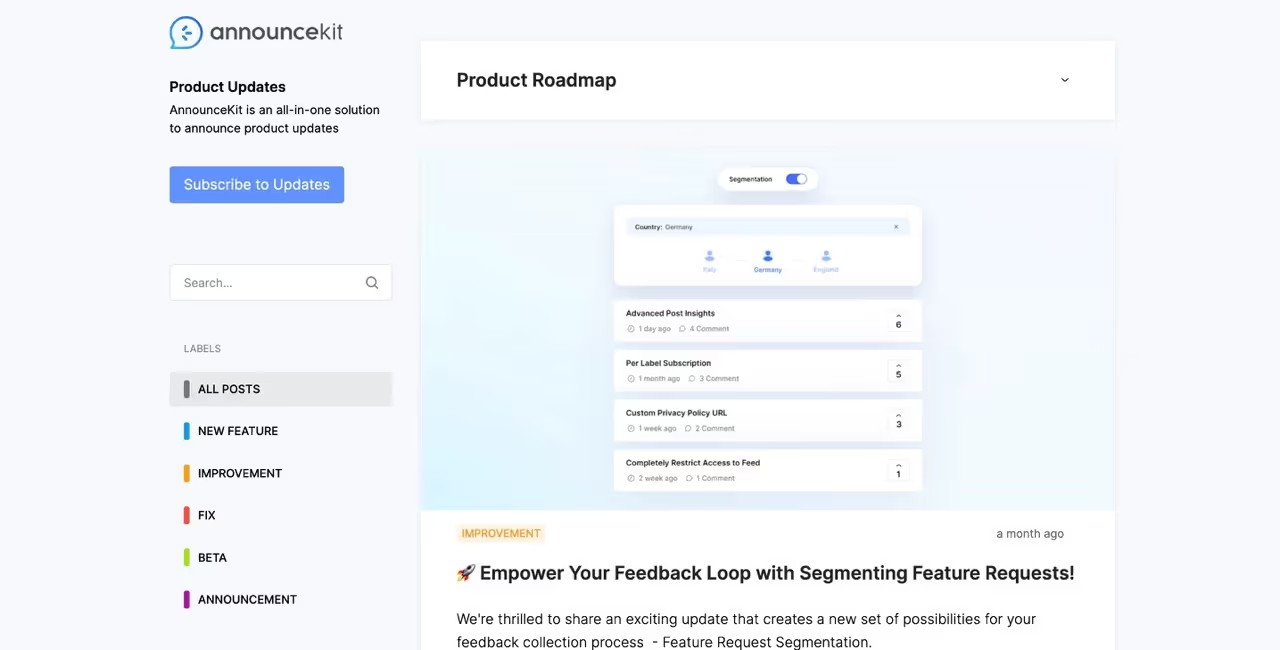

TL;DR:
- UserGuiding, Canny, Beamer, AnnounceKit, LaunchNotes, Feature Upvote, and Headway are top changelog tools for product managers.
- These tools streamline the product update process, improve user engagement, and provide detailed information about changes.
- They offer features like automated notifications, customizable widgets, labels for segmentation, and feedback organization.
- Users can stay informed about new features, bug fixes, and improvements through public or private changelogs.
- Utilizing these tools helps businesses build transparency, and trust, and gather valuable insights from users.
From my health app to my banking applications, I have to manually update some of my mobile apps almost every other week.
And, yes... I have my automatic updates on 😮💨
So, I go to the application store, tap on the update button, but you know what I don't do?
Read what the update is about — I'm pretty sure most can relate.
That's why yesterday, when I came upon a newly-added changelog on my favorite software, I found it to be practical; it doesn't disrupt the in-app experience yet still finds a way to present the latest product changes, whether it's an addition, fix, or removal.
If only my favorite mobile application had one...
Well, on the brighter side, UserGuiding just launched Product Updates, which aligns user onboarding with product changes by offering a changelog that provides a clear overview of updates.
In this article, I'll present you with the best changelog tools so that you can choose the one that fits your business the best.
1. UserGuiding
UserGuiding's new feature, Product Updates, is a must-have to take your communication strategy to the next level.
This feature enables you to create a changelog as a standalone page or in-app widget to inform your audience about what your product team has been cooking up backstage.
You can publish posts, label them, and see how your users are reacting to these changes with both emojis and comments on your dashboard.

Check out how we utilized this feature by customizing the page and publishing our latest updates!
What's more, you'll be able to utilize a functionality called Booster, which encourages users to take a look at the newest changes through UI indicators when they're in the product.
In short, you can say goodbye to the days of manually updating changelogs and hello to a streamlined, automated process that will keep your users in the loop at all times.
2. Canny
Canny is here to help your audience engage better with your software product.
Urging users to check the product updates along with release notes, Canny automatically notifies the users when a new update is added to the changelog.

Here, you can see how release notes are embedded inside the product widget.
Informing users about the latest updates, this changelog tool allows you to maintain a recording system directly within the platform. There are also several elements that you can utilize to customize the whole process for your audience.
Along with the ability to upload your logo, you'll be able to set any hex value as your brand color — which you can check while applying to make sure you're creating a visually pleasing widget, not an eyesore.
Keeping your users engaged and satisfied, Canny encourages your users to explore new features and functionalities within your SaaS tool.
3. Beamer
Breaking the chains of customer engagement, Beamer is a solution that manages to guide in and out of your product with changelogs.
Beamer offers these changelogs in three different forms for users to utilize:
- standalone page,
- in-app widget,
- website widget.
First, changelogs can be displayed on a standalone page that lists every product update chronologically.
The latter forms can be implemented on a specific page in the form of a widget, whether it's inside your product or on your webpage.

Notice how the right tab shows the changes on a different page while the left tab displays the widget form on Beamer's webpage.
Choosing the right platform for your changelog, it's time to dive deeper into how you can make the most out of this changelog software.
Onto the next step:
Make sure your custom branding is on point👌 With several design options, you can modify the widget in cohesion with the elements of your product's UI.
4. AnnounceKit
Keeping it transparent, AnnounceKit streamlines the product update process with detailed changelogs.
Not only does it help you effectively manage your changelogs and communicate with your users by offering several elements that boost user retention, but it also improves your communication efforts with less time.
One of these elements is labels, which are quite practical for segmenting the posts that you put in your changelog. With labeling, you enable users to see the relevant updates of the category they choose at the beginning.

Thanks to the labels on the left, users can easily navigate through the changelog.
Don't forget that labels are truly the must-have element when going through a stand-alone changelog page since they facilitate navigation based on different criteria and improve user experience single-handedly.
5. LaunchNotes
LaunchNotes is another solution you can adopt to eliminate all the struggles regarding the product changes cycle.
Gone are the days of cryptic release notes that leave your users scratching their heads – with LaunchNotes, you can provide clear and concise information about each update, ensuring that your users are always up to date on the latest changes to your product.
After selecting your preferred channel for product communication and collaboration, you'll be able to announce any update regarding:
- new features,
- bug fixes,
- feature enhancements,
- and improvements.
Also, keep in mind that these changelogs don't have to be public: You might even publish private changelogs for internal alignment and coordination.
6. Feature Upvote
Businesses can build trust with their customers by providing detailed information about each change, categorizing updates, and gathering feedback — which also happens to be exactly what Feature Upvote offers.
Feature Upvote provides you with a space in which you can organize customer feedback, see how many upvotes an idea got, and label these ideas with the stage these ideas are at so that users can see what the product team is working on.
Enabling users to see that the company is actively working to improve their product helps in building transparency and trust as well.
Another advantage that I should let you in on is teams get to have comprehensive data (all thanks to feedback) as they get to see how customers are responding to their updates and whether they are meeting their needs and expectations.
7. Headway
Headway is an application that focuses on streamlining the announcement process of product updates that are on their way.
On Headway's changelog widget, users get to see detailed information about each change, including the date it was made, the reason for the change, and any other relevant details — helping customers understand why certain changes were made and how they will benefit from them.

Check out how simple changelogs are easy on the eye.
Also, you can schedule publishing by setting a specific time that you want your changelog to be published, which paves the way for you to focus on other tasks at hand.
Wrapping Up
Product changelog pages generate awareness regarding the changes and updates on the product roadmap.
Businesses can keep it in-house and spend the dev team's time on building a changelog, but opting for a third-party product changelog tool can save more time and ease the workflow.
A good changelog tool should:
- have a user-friendly and intuitive interface,
- be easy to use,
- collect feedback,
- notify users,
- have customization option,
- streamline roadmap management,
- improve collaboration among the internal team,
- increase customer retention.
With the help of these tools, businesses can create and manage non-technical changelogs in one place.
By the way, changelogs tend to help businesses gather valuable insights from users and display how they are responding to the changes being made to the product — so, it's a win-win.
Frequently Asked Questions
What is a changelog tool?
Changelog tools are applications that automate the process of creating a changelog. These tools help teams build a changelog while eliminating the need for coding.
How do I create a changelog?
There are two ways you can create a changelog: You can develop it by coding it on your own, or you can get the aid of a third-party tool to streamline the process. While the developer team has to work for the in-house option, third-party tools don't require someone who has experience in coding.
How do you make a good changelog?
To make a good changelog, you should place importance on publishing changes on time, designing a user-friendly page, writing a clear and brief copy, labeling your posts for easy navigation, and reviewing feedback.

















.svg)
.svg)
.svg)
.svg)
.svg)

.svg)
.svg)












.svg)
.svg)




.png)
















